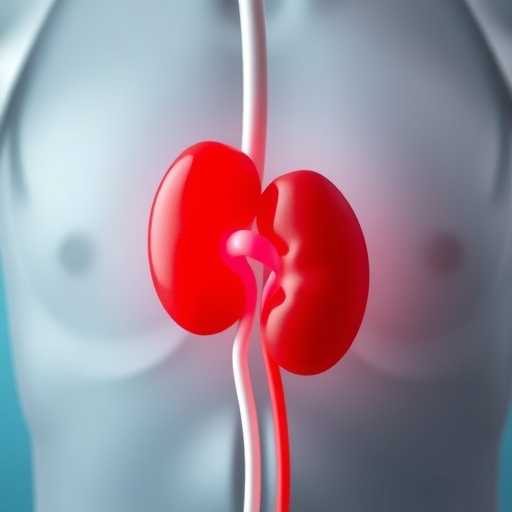Recent advancements in neuroscience and gut health have provided compelling insights into the management of digestive disorders such as Irritable Bowel Syndrome with diarrhea (IBS-D). Among the innovative approaches being explored, a traditional Chinese medicine formula known as Changji’an has garnered attention for its potential to mitigate the visceral hypersensitivity associated with IBS-D. This phenomenon is often linked to post-inflammatory responses, where heightened sensitivity of the gastrointestinal tract leads to significant discomfort and disruption in daily life. Understanding the underlying mechanisms through which Changji’an operates offers a promising avenue for developing more effective treatments for this debilitating condition.
A pivotal study conducted by researchers, including Ke, Huang, and Zhu, aimed to elucidate the pathways through which Changji’an exerts its therapeutic effects in a mouse model representative of post-inflammatory IBS-D. The focus of their investigation was specifically on the nerve growth factor (NGF) and its receptor, TrkA, which play critical roles in the modulation of pain and sensitivity in visceral organs. Visceral hypersensitivity is a defining characteristic of IBS, yet the specific biochemical and signaling nuances have remained less understood until now.
As the study revealed, the NGF/TrkA signaling pathway is fundamentally involved in the sensation of pain and discomfort within the gastrointestinal tract. Pain pathways are often activated following an inflammatory response, which can result in chronic inflammation and sustained sensitivity in the bowel. The Changji’an formula appears to intervene in this signaling cascade, effectively reducing the hypersensitivity that characterizes IBS-D. This groundbreaking discovery not only highlights the importance of NGF in visceral pain syndromes but also positions Changji’an as a potential therapeutic agent in the management of IBS.
The research utilized a comprehensive approach, employing advanced experimental techniques to assess the physiological and molecular changes induced by the Changji’an formula. Mice affected by post-inflammatory IBS-D were treated with the formula, and subsequent evaluations were conducted to determine changes in their sensitivity levels. The results were striking; the treatment led to a significant reduction in visceral hypersensitivity, evidenced by both behavioral and biochemical assessments.
Furthermore, analysis of the digestive systems of the mice subjected to Changji’an revealed a reduction in the expression of NGF and TrkA. This is particularly significant, as it suggests that the formula actively downregulates the factors that contribute to visceral hypersensitivity. The ability to modulate such key signaling molecules introduces Changji’an as not merely a symptomatic relief agent but a potential disease-modifying treatment option.
In this context, it is essential to understand how traditional remedies like Changji’an can be integrated into modern medical frameworks. The study underscores the necessity for further clinical exploration of herbal formulations that have historically been employed in Eastern medicine. The synergy between traditional practices and contemporary scientific validation could pave the way for innovative therapeutic strategies for persistent conditions like IBS-D.
Amidst the backdrop of a rising interest in complementary and alternative medicine, the findings by Ke and colleagues could also broaden the applicability of Changji’an beyond gastrointestinal disorders. The broader implications of targeting the NGF/TrkA signaling pathway could extend to various pain and chronic inflammatory conditions, presenting an exciting frontier for future research.
However, it is imperative to approach these findings with a balanced perspective. While the data supports the efficacy of Changji’an in murine models, extensive clinical trials involving human populations will be necessary to confirm its safety and effectiveness. Moreover, the complexity of IBS as a heterogeneous condition necessitates careful consideration of individual patient profiles and underlying biological factors that may influence treatment outcomes.
Moreover, the study invites a dialogue surrounding the intersections of traditional knowledge and empirical investigation. As researchers continue to bridge these worlds, questions regarding standardization, preparation methods, and dosages of herbal formulations become increasingly relevant. Establishing rigorous protocols will be essential for ensuring consistency and maximizing therapeutic potential in clinical applications.
Engagement in multidisciplinary research efforts combining biochemistry, pharmacology, and traditional medicine can give rise to a holistic understanding of how such formulations operate at multiple levels within the body. Changji’an’s ability to alleviate visceral hypersensitivity positions it at the forefront of a transformative movement in addressing IBS-D, portraying a new narrative in chronic pain management.
The implications of the findings from this study extend beyond mere symptom management. By exploring the NGF/TrkA signaling pathway, researchers have opened avenues for understanding how targeting pain at its source can lead to better quality of life for patients suffering from IBS-D. Continuous research in this field may unearth additional layers of understanding, leading to novel interventions that could revolutionize the management of digestive and pain-related disorders.
As we look toward the future, this study serves as a crucial reminder of the value found at the intersection of traditional practices and scientific exploration. The potential for Changji’an and other herbal formulations to lay the groundwork for new treatment paradigms reflects the evolving landscape of medicine rooted in both time-honored wisdom and cutting-edge research.
Moving forward, researchers are encouraged to explore the pharmacodynamics and pharmacokinetics of Changji’an, as these factors will dictate its clinical relevance. Furthermore, comprehensive studies focusing on the long-term efficacy and safety of the formula are essential to meet the stringent standards of modern medical practice. The groundwork laid by Ke, Huang, and Zhu invites a forward-thinking approach that could reshape the understanding and treatment of IBS-D, ultimately leading to enhanced patient outcomes and a brighter future for those affected by this challenging condition.
In conclusion, the recent findings pertaining to the Changji’an formula and its impact on visceral hypersensitivity through NGF/TrkA signaling pathway represent a significant step forward in the field of gastrointestinal research. This study illuminates not only the direct effects of a traditional remedy but also offers a framework for integrating complementary approaches into contemporary healthcare. As the dialogue around such innovations becomes more prominent, the journey to unravel the complexities of IBS-D continues to evolve, nurturing hope for many in search of relief and understanding.
Subject of Research: The therapeutic effects of Changji’an formula on visceral hypersensitivity in a post-inflammatory IBS-D mouse model.
Article Title: Changji’an formula alleviates visceral hypersensitivity of a post-inflammatory IBS-D mouse model via NGF/TrkA signaling pathway.
Article References:
Ke, W., Huang, S., Zhu, H. et al. Changji’an formula alleviates visceral hypersensitivity of a post-inflammatory IBS-D mouse model via NGF/TrkA signaling pathway. BMC Complement Med Ther 25, 348 (2025). https://doi.org/10.1186/s12906-025-05095-3
Image Credits: AI Generated
DOI: 10.1186/s12906-025-05095-3
Keywords: IBS-D, visceral hypersensitivity, Changji’an formula, NGF/TrkA signaling pathway, traditional medicine, chronic pain management.
Tags: Changji’an formula for IBS-Deffective treatments for digestive discomfortgut health and neuroscience advancementsIBS-D treatment innovationsnerve growth factor NGF pathwaypain modulation in gastrointestinal disorderspost-inflammatory IBS-D managementsignaling pathways in visceral paintherapeutic effects of Changji’antraditional Chinese medicine for digestive disordersunderstanding IBS-D mechanismsvisceral hypersensitivity in IBS-D





